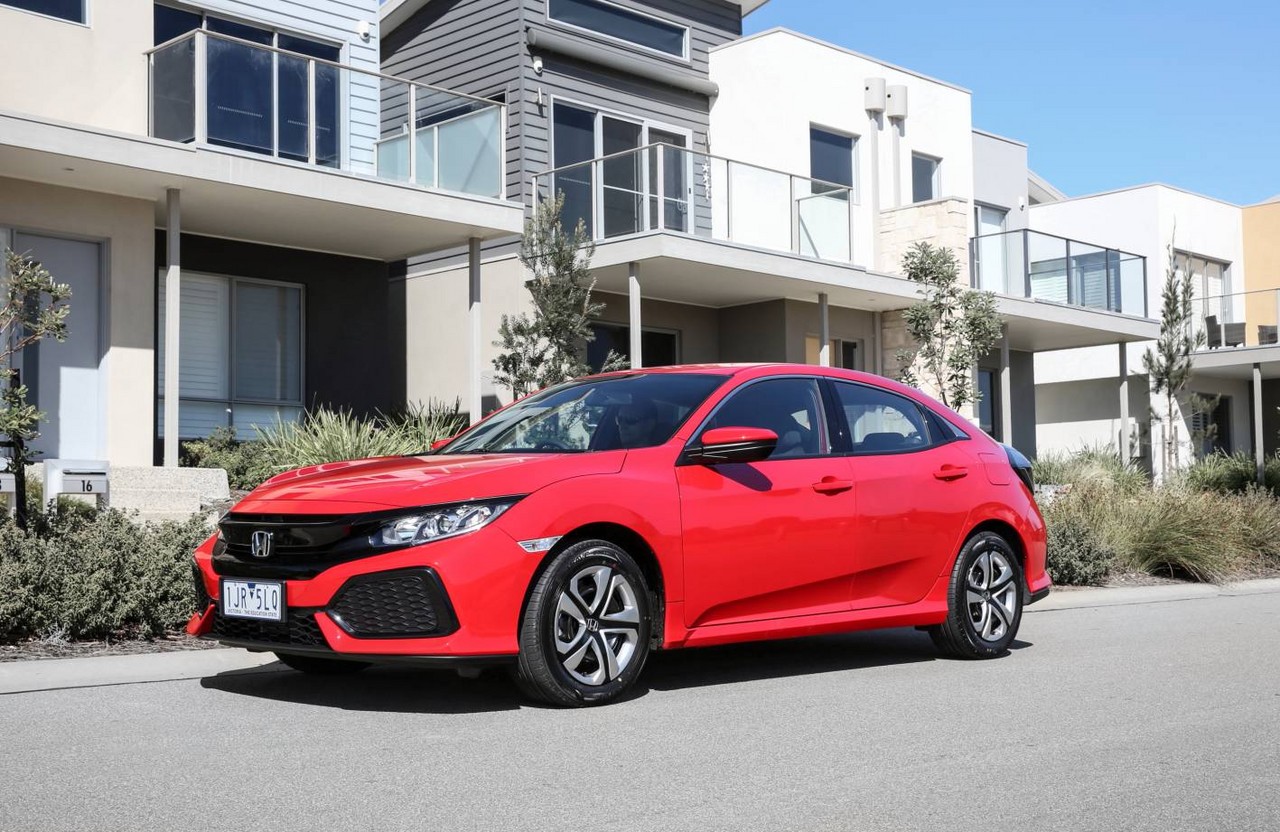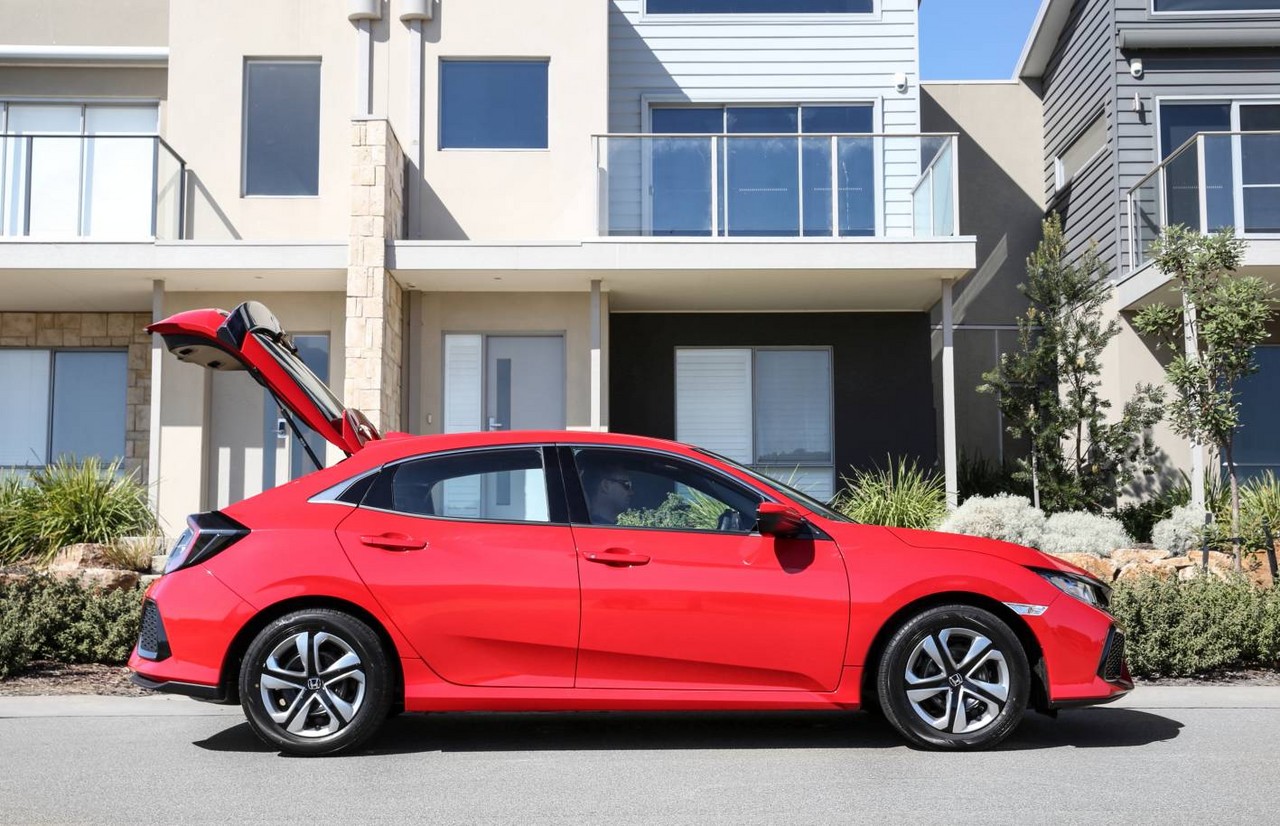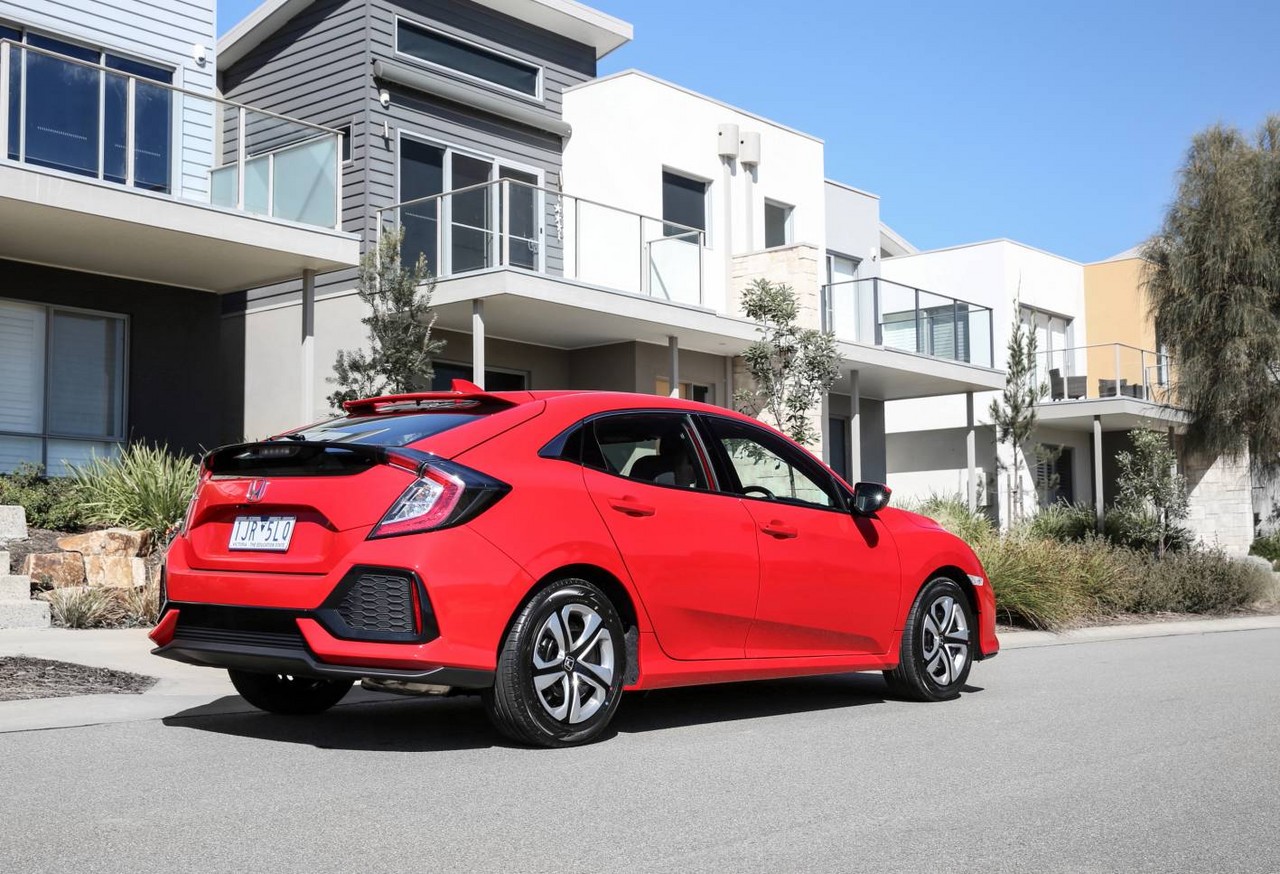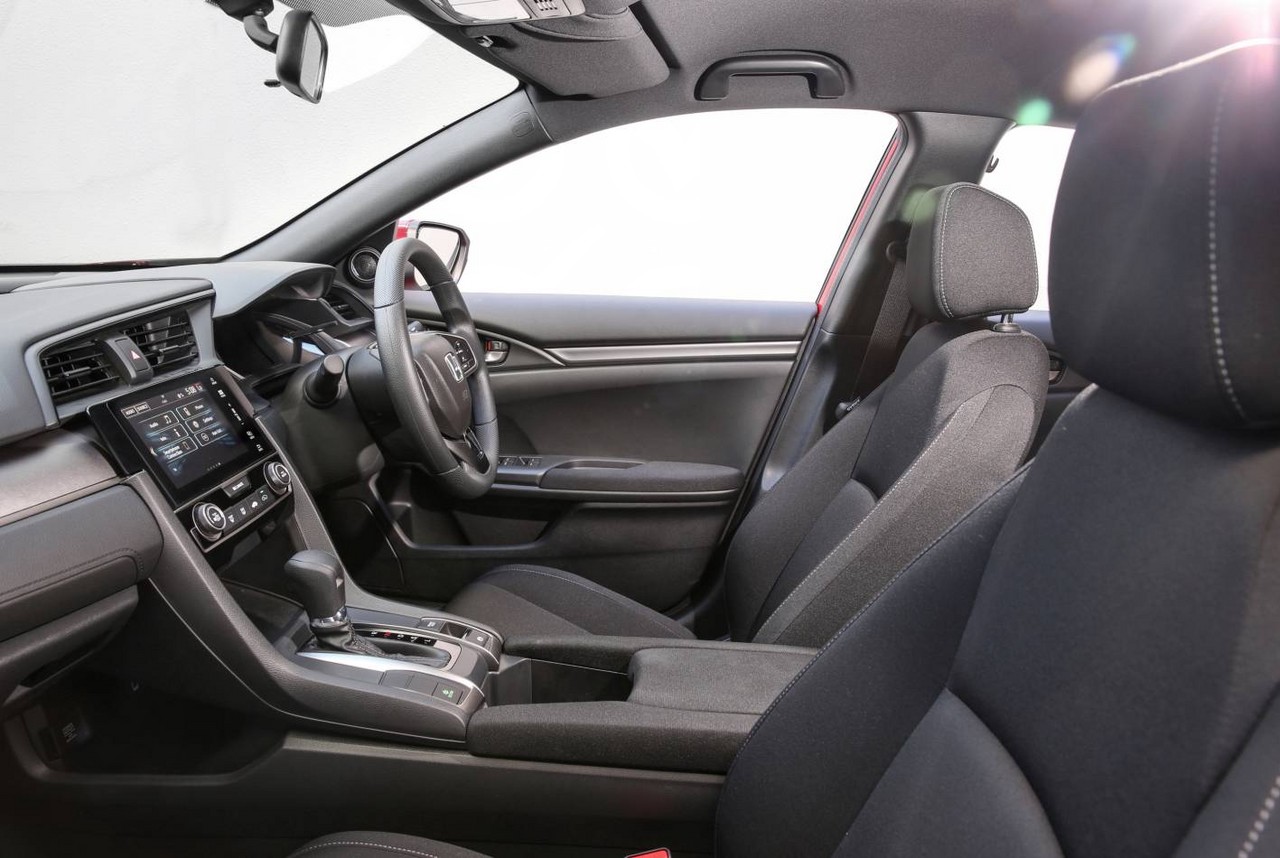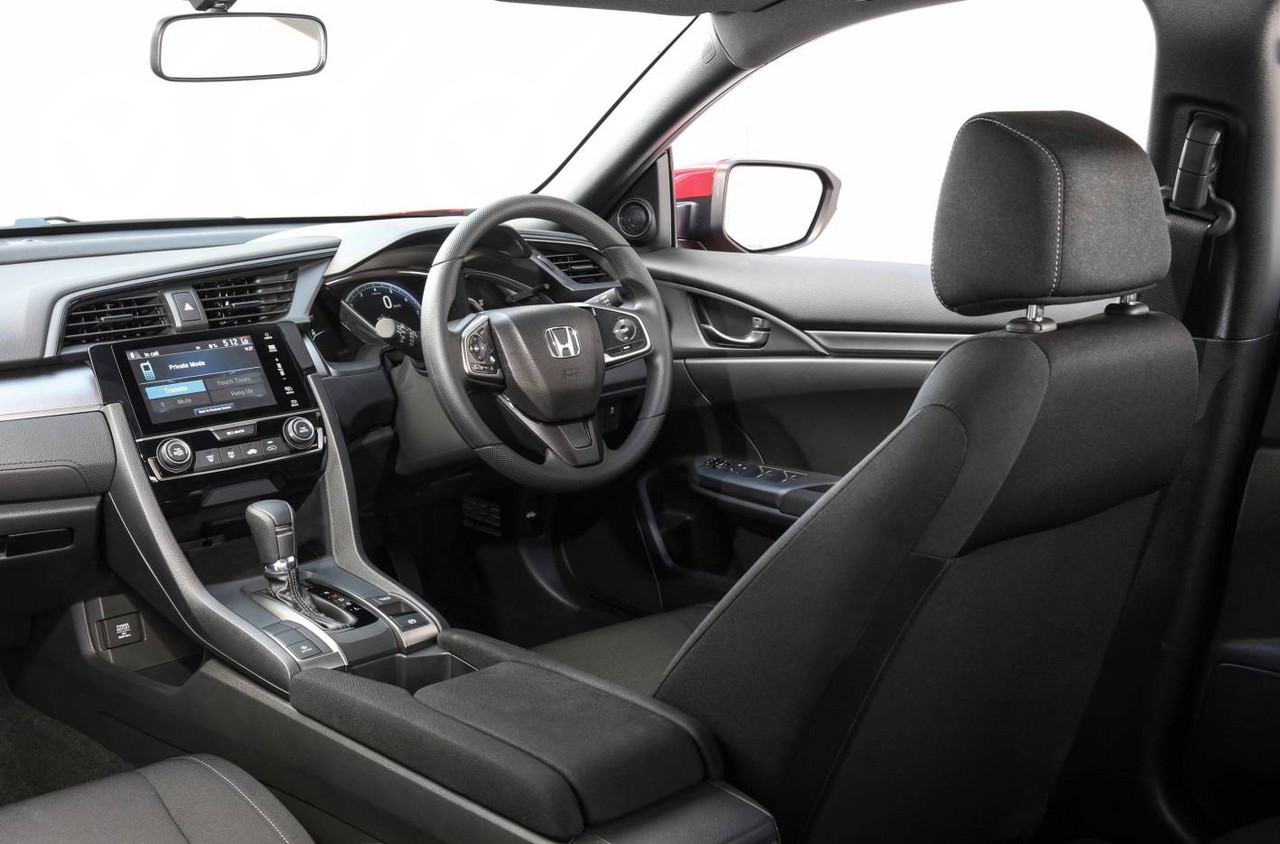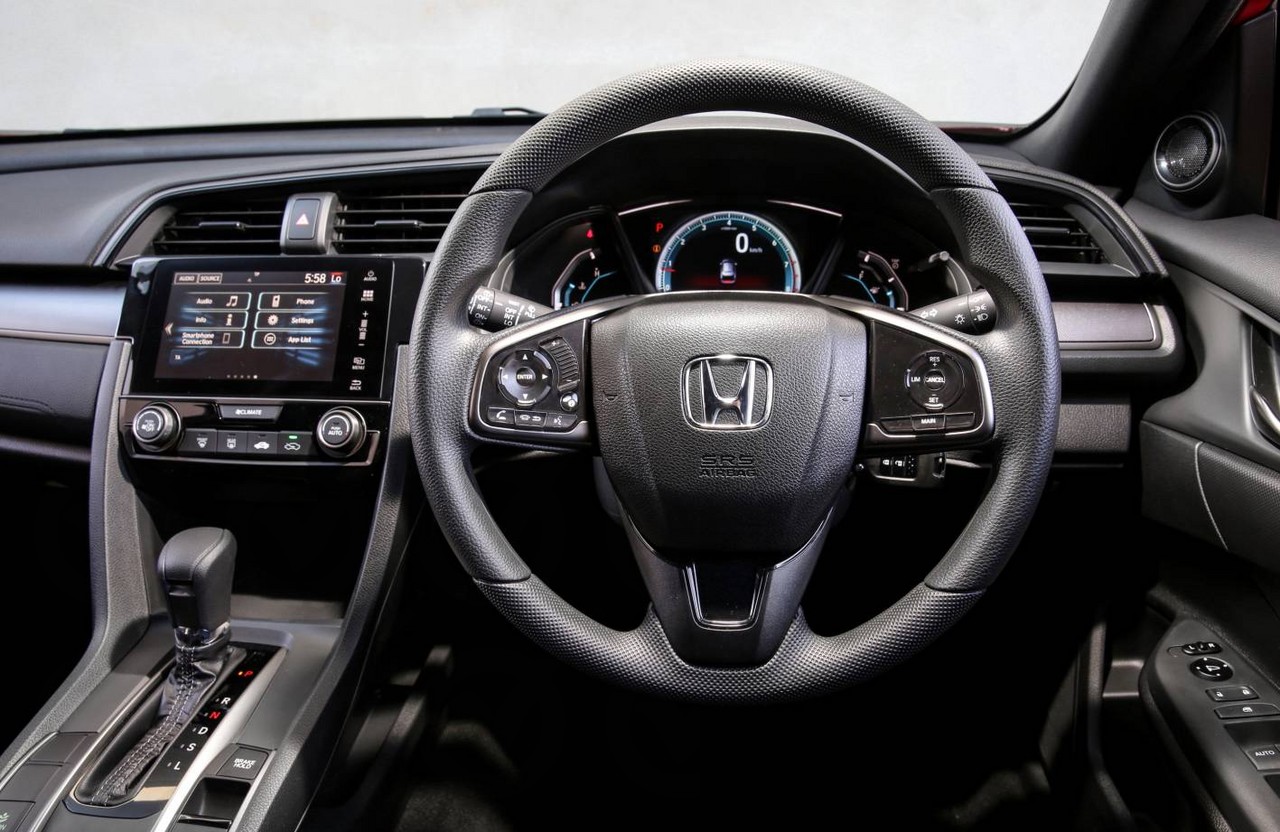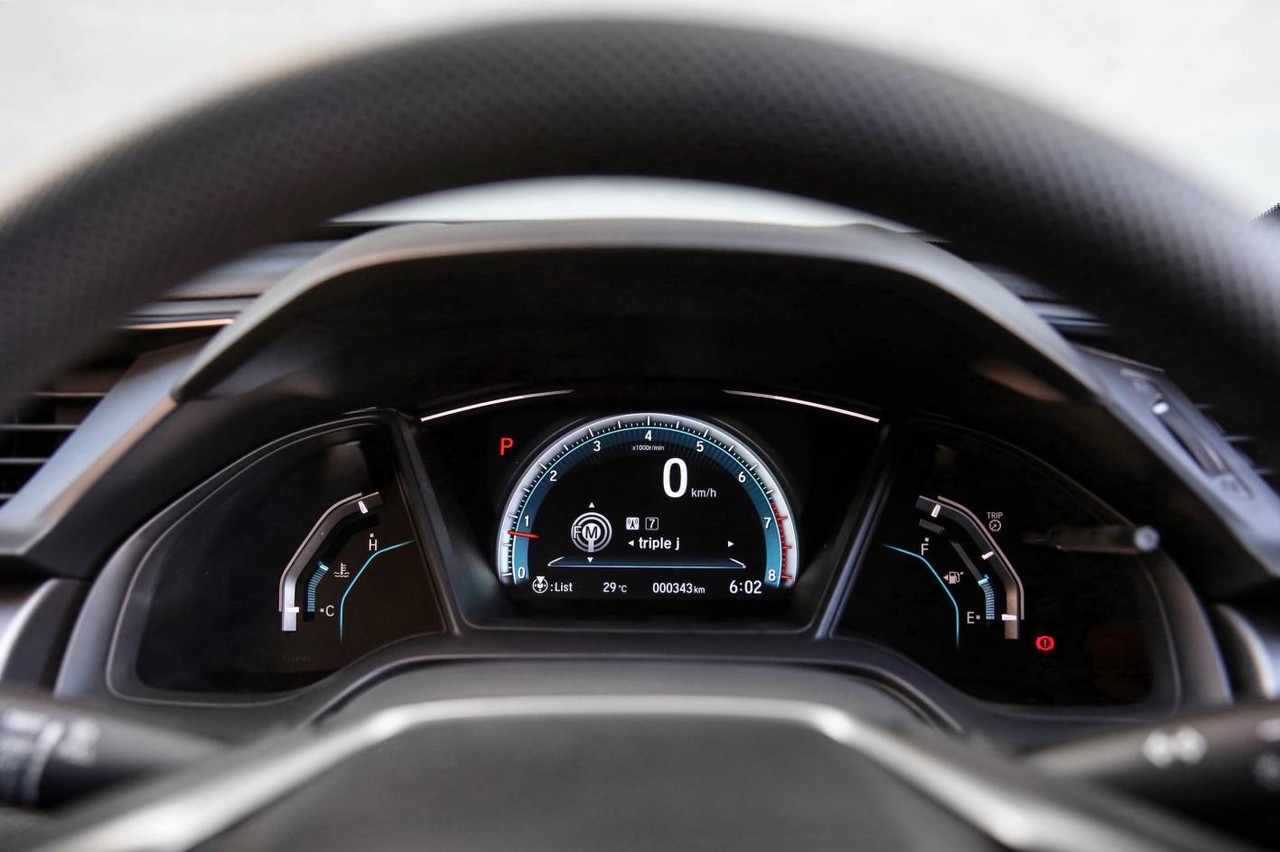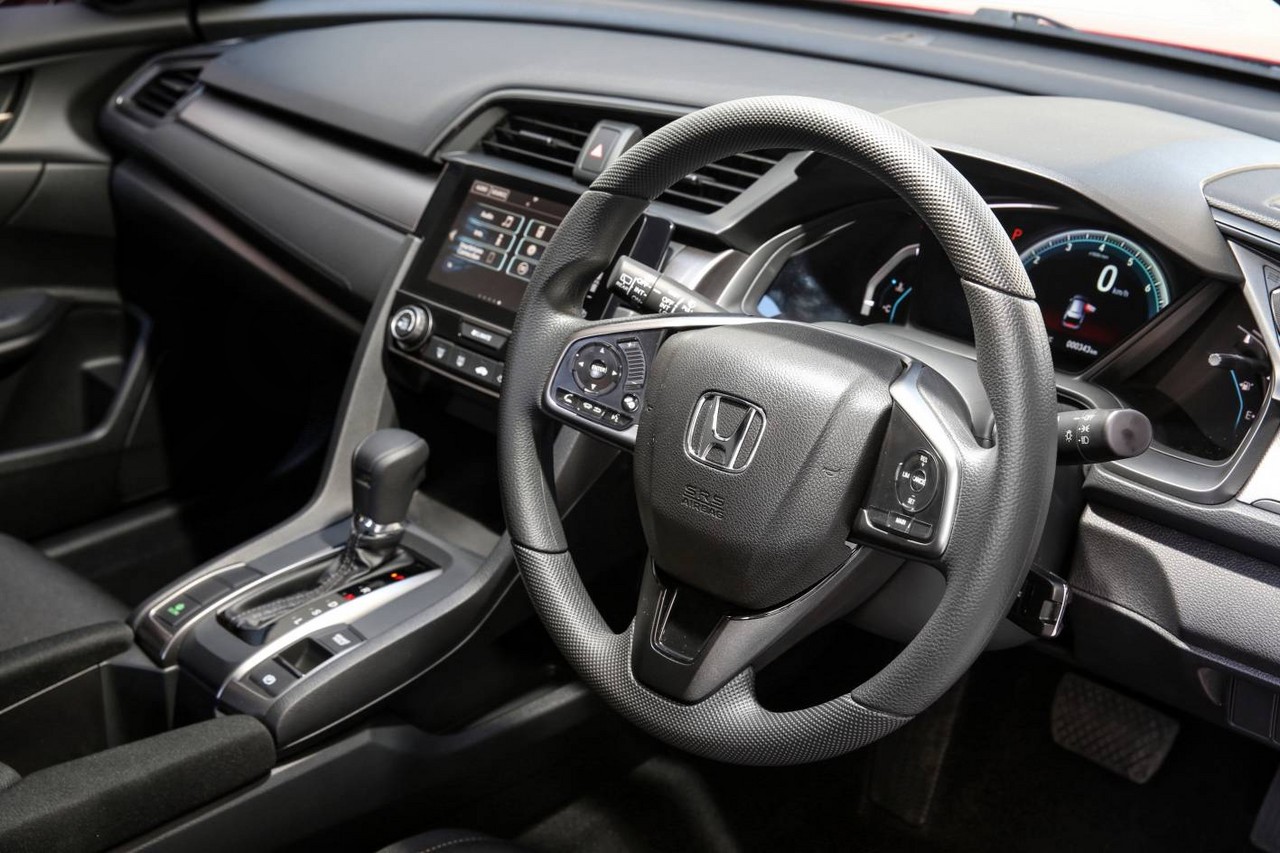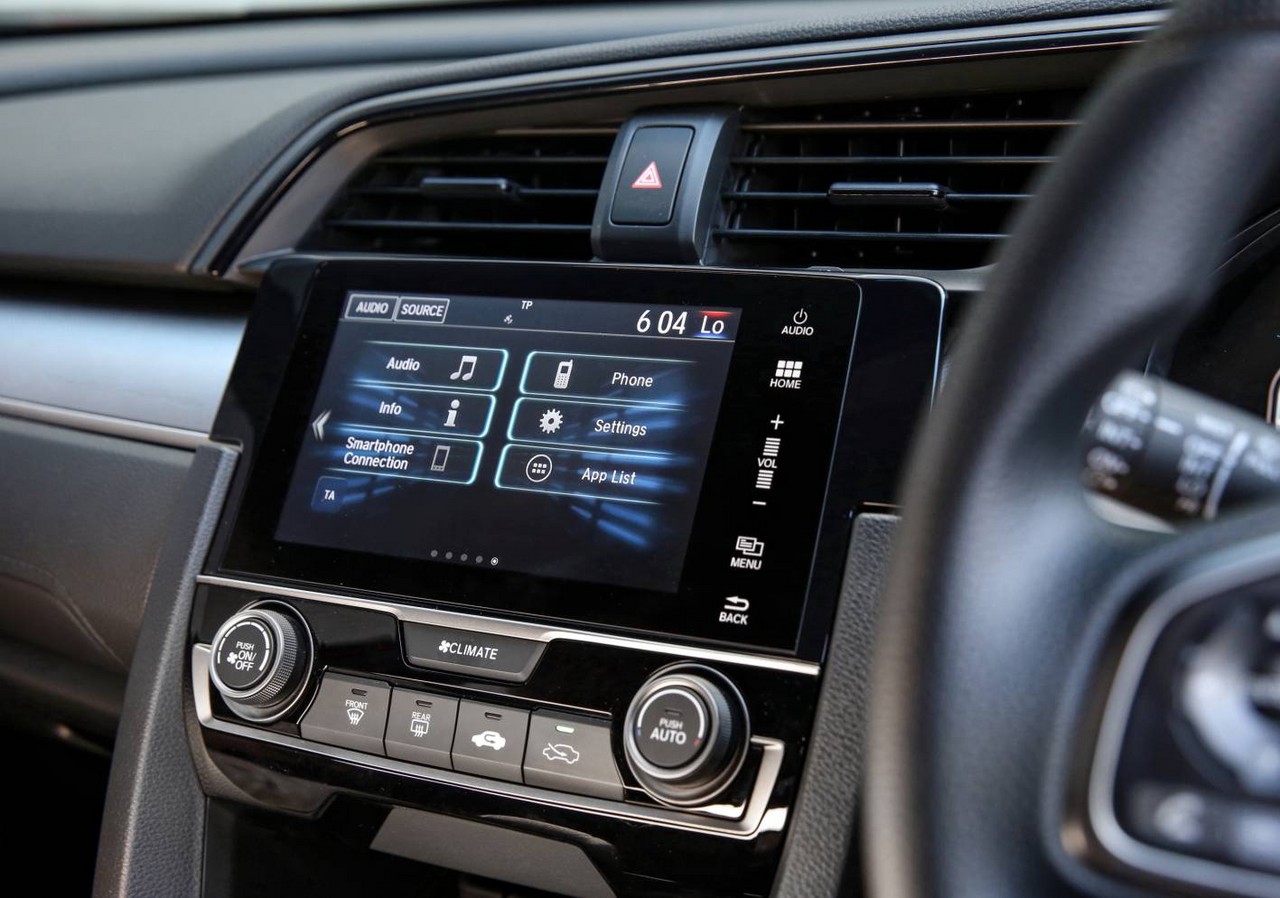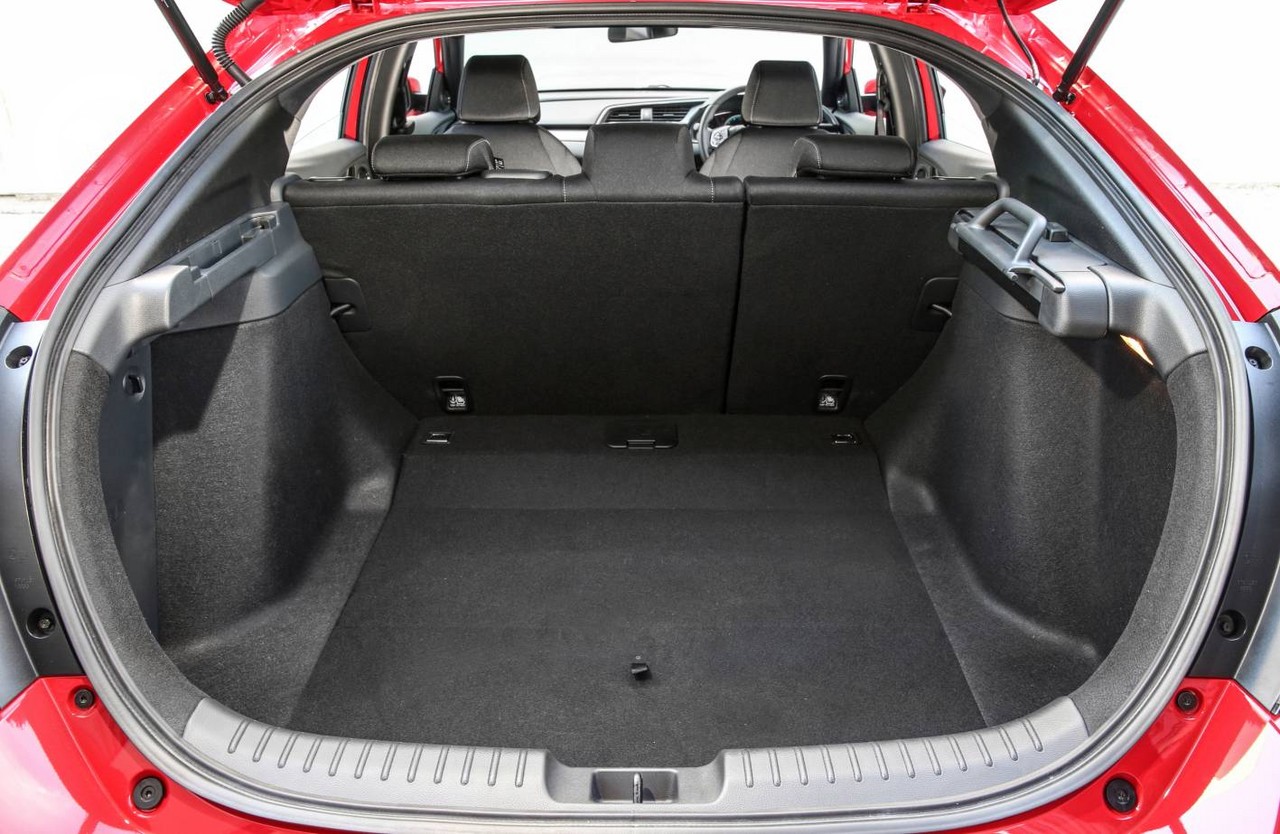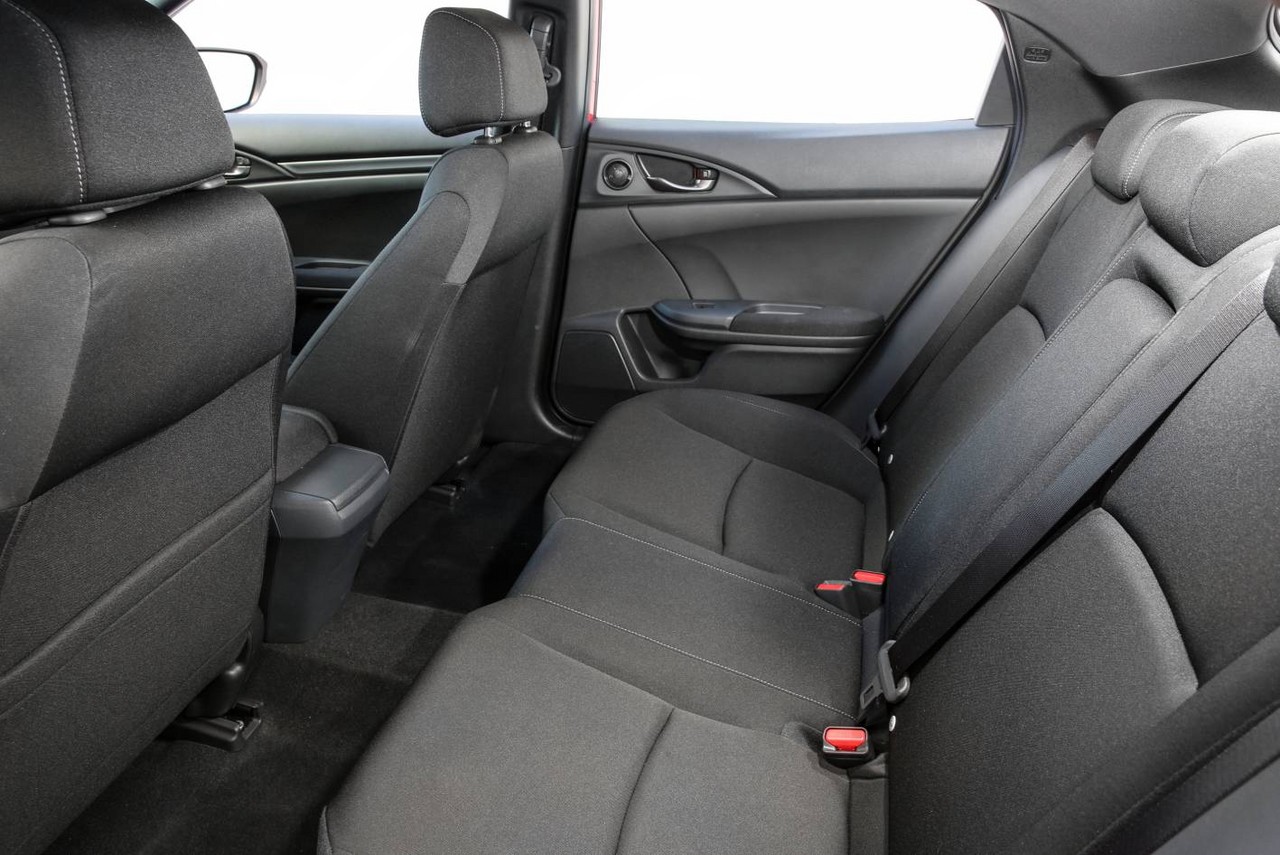
- Responsive 1.5-litre turbo petrol engine
- Spacious interior, including rear seat leg and headroom
- Multi-link rear suspension contributes to comfortable ride
- Well-weighted steering
- Misses out on the folding ‘magic seats’ of the FK2/FK3 Civic hatch
- Handling prowess and chassis balance fall short of class leaders
- CVT contributes to sluggish throttle response
- Hard interior plastics
Overview
Released in Australia in May 2017, the Honda FK4 and FK5 Civics were small hatchbacks that were powered by 1.5-litre turbocharged and 1.8-litre naturally aspirated petrol engines, respectively. Manufactured at Honda’s Prachinburi plant in Thailand, the front-wheel drive Honda FK4 Civic range consisted of VTi-L, RS and VTi-LX variants, while the FK5 Civic range consisted of VTi and VTi-S variants.
From 1 July 2017, the Honda FK4/FK5 Civic Hatch was sold with a five year, unlimited kilometre warranty; if the vehicle was used for commercial purposes, however, the warranty was limited to five years or 140,000 kilometres, whichever came first.
Honda FK5 Civic: R18Z1 engine
For the Honda FK5 Civic hatch, the 1.8-litre R18Z1 four-cylinder petrol engine had an aluminium-alloy block and cylinder head, a single overhead camshaft (chain-driven), four valves per cylinder, a variable length intake manifold, drive-by-wire throttle control and a compression ratio of 10.6:1. The engine also featured Honda’s i-VTEC (Intelligent Variable Valve Timing and Lift Electronic Control) system which used two distinct camshaft profiles to vary intake valve timing and lift for low RPM (1500-3500 rpm) and high RPM (5200-7000 rpm) operations.
Honda FK4 Civic: L15B7 engine
For the Honda FK4 Civic hatch, the L15B7 engine had a die-cast aluminium block with 73.0 mm bores and an 89.4 mm stroke for a capacity of 1496 cc. Within the block, the L15B7 engine has cast-in iron cylinder liners and the cylinder walls undergo a ‘plateau honing’ process to remove ‘microscopic high points’. Within the crankcase, the forged-steel crankshaft has micro-polished journals to reduce friction and the high-strength steel connecting rods are heat-forged in one piece and then ‘crack separated’ to create a light and stronger rod with an optimally fitted bearing cap. The aluminium pistons have an optimised skirt design to reduce reciprocating weight and a molybdenum coating for the outer skirts – applied in a dot pattern – to reduce friction. Furthermore, the pistons have ion-plated piston rings to reduce friction and are cooled by twin oil jets directed at the underside of each piston crown.
The L15B7 engine has a pressure-cast aluminium alloy cylinder head that contains chain-driven, hollow double overhead camshafts with electronically-controlled Variable Timing Control (‘VTC’) for both the intake and exhaust camshafts. Of the four valves per cylinder, the exhaust valves are sodium-filled for heat dissipation.
To eliminate the need for a separate exhaust manifold, exhaust ports are cast into the cylinder head. The L15B7 engine features a single-scroll MHI TD03 turbocharger which has a nine-blade turbine impeller, electronic waste gate and provided peak boost pressure of 1.15 bar (16.5 psi). Furthermore, the L15B7 engine has direct injection via multi-hole injectors and a compression ratio of 10.6:1.
| Variant | Engine | Trans. | Peak power | Peak torque | |
|---|---|---|---|---|---|
| FK5 Civic hatch | VTi, VTi-S |
1.8-litre R18Z1 petrol I4 | CVT | 104 kW at 6500 rpm | 174 Nm at 4300 rpm |
| FK4 Civic hatch | VTi-L, RS, VTi-LX |
1.5-litre L15B7 turbo petrol I4 | CVT | 127 kW at 6000 rpm | 220 Nm at 1700-5500 rpm |
Continuously Variable Transmission (CVT)
The Honda FK4/FK5 Civic had a continuously variable transmission (CVT) which consisted of an engine-driven torque converter which drove two variable-width pulleys that were connected by a steel belt. The steel belt had angled inner faces so that it could circle the angled pulley faces at varying diameters depending on the pulley width which adjusted the effective ratio between the pulleys. Computer control of the CVT enabled the ratio between the pulleys to be altered to suit driving conditions and accelerator pedal position.
For the turbocharged FK4 Civic, the CVT featured Honda’s ‘G-Design’ shift logic which Honda claimed to improve acceleration and provide ‘a more familiar driving feel’. Furthermore, a turbine twin-damper design for the torque converter was claimed to provide ‘tighter control’ and reduce turbo lag during acceleration.
Dimensions
Compared to the Honda FK2/FK3 Civic hatch , the FK4/FK5 Civic are 185 mm longer (at 4515 mm), 29 mm wider (1799 mm), 54 mm lower (1421 mm) and have 95 mm longer wheelbases (2700 mm). Furthermore, the body-in-white of the FK4/FK5 Civic was 16 kg lighter than the FK2/FK3 Civic, yet achieved a 52 per cent increase in torsional rigidity.
The Honda FK4/FK5 Civic had a cargo volume of 414 litres.
Suspension
Sharing its platform with the Honda FK4/FK5 Civic sedan , the FK4/FK5 Civic hatch had MacPherson strut front suspension in which the lower suspension arms were connected to the sub-frame and to the body via fluid-filled bushings. The front suspension also included a tubular front stabiliser bar.
The independent, multi-link rear suspension – which included stamped-steel arms, cast aluminium hub carriers and a stabiliser bar – was mounted on a sub-frame. Furthermore, the trailing arms were located on the unibody in fluid-filled bushings and the rear suspension included a solid rear stabiliser bar.
Steering
The Honda FK4/FK5 Civic had rack-and-pinion steering with electric power assistance. The steering incorporated dual-pinion gears for improved steering feel and variable gear ratios. Furthermore, the Civic’s steering wheel required 2.2 turns from lock-to-lock.
Safety equipment
Standard safety equipment for the Honda FK4/FK5 Civic included dual front airbags, front side airbags, full-length curtain airbags, ABS, electronic brake force distribution, brake assist, electronic stability control, traction control and front seatbelts with pre-tensioners and load limiters.
Beyond this, the Honda Civic VTi-S, VTi-L, VTi-LX and RS were fitted with Honda’s ‘LaneWatch’ system which used a camera to increase the view of the passenger-side mirror by up to 80 degrees, with the camera feed visible on the multi-information display.
The Honda FK4 Civic VTi-LX was also equipped with:
- Forward Collision Warning (FCW) and Collision Mitigation Braking System (CMBS): operating at speeds above 15 km/h, FCW and CMBS used millimetre-wave radar and a camera located in the windscreen to monitor the road up to 100 metres ahead. If FCW detected that there was a collision risk with the vehicle ahead, a ‘Brake’ warning would flash in the Multi-Information Display and an audible warning would sound. In its second stage, CMBS would apply light braking to reduce vehicle speed and alert the driver. In its final stage when a collision was assessed to be inevitable, CMBS would apply maximum braking force to reduce vehicle speed and the severity of the collision;
- Lane Keep Assist System (LKAS): used a camera to detect if the vehicle was departing from its lane without indicating and, if so, automatically applied corrective steering inputs (‘Road Departure Mitigation System’). Visual and audible warnings were also issued (‘Lane Departure Warning’, LDW); and,
- Adaptive Cruise Control (ACC): operating at speeds above 30 km/h, ACC enabled the vehicle to maintain a specified distance from the vehicle ahead and could apply up to a quarter of the maximum braking force to slow the vehicle if it was approaching the vehicle ahead.
Euro NCAP and ANCAP safety ratings
In Euro NCAP testing , the 2017 Honda Civic hatch received a four star safety rating which included a 92 per cent adult occupant protection rating and a 67 per cent child occupant protection rating. In the frontal offset test, protection of the driver’s head, neck, thighs and feet were rated as good, though protection of the chest and lower legs was rated as adequate (i.e. a slight risk of serious injury). For the frontal full width test, protection of the driver’s chest was rated as adequate and protection of the rear passenger’s chest was rated as weak (a high risk of serious injury). Maximum points, however, were awarded in the side impact and pole tests.
In ANCAP crash testing , the Honda FK4/FK5 Civic sedan received a five star adult occupant protection rating with a score of 34.68 out of 37, and this rating was also applied to the FK4/FK5 Civic hatch . In the frontal offset tests, protection of the front occupants’ heads and upper legs were rated as good, though chest and lower leg protection were rated as adequate (i.e. a slight risk of serious injury). In the side impact test, protection of the head, abdomen and pelvis were rated as good, though chest protection was rated as adequate.
Brakes
The Honda FK4 and FK5 Civic hatches had 282 mm by 23 mm ventilated front brake discs and 260 mm by 9 mm solid rear discs.
Features: Honda FK5 Civic VTi
As standard, the Honda Civic VTi was fitted with Honda’s ‘Advanced Display Audio’ system which included a 180 watt sound system with eight speakers, a seven-inch colour touch screen, an AM/FM radio, Bluetooth mobile phone connectivity and audio streaming, USB connectivity and smartphone integration via Apple CarPlay and Android Auto.
Other standard features for the Honda Civic VTi included 16-inch steel wheels with 215/55 R16 tyres, black fabric seat trim, single-zone climate control air conditioning, cruise control with speed limiters, halogen headlights, LED daytime running lights, a rear view camera with dynamic guidelines, 60:40 split fold rear seats, remote central locking, power door mirrors, power windows, tilt and telescopic steering wheel adjustment, an electric parking brake, a 12 volt power socket in the front console, a tyre deflation warning system, trip computer, an alarm and immobiliser.
Relative to the Honda FK4/FK5 Civic sedan , visual cues for the FK4/FK5 Civic hatch included ‘piano black’ front grille and B-pillar finishes, a body-coloured upper tailgate spoiler and black lower rear spoiler.
Features: Honda FK5 Civic VTi-S and FK4 Civic VTi-L
Compared to the Civic VTi, the Civic VTi-S was further equipped with 16-inch alloy wheels, premium black seat trim, halogen front fog lights, parking sensors (front and rear), a leather-wrapped steering wheel, a proximity key (i.e. keyless entry) and push-button start. Furthermore, the Civic VTi-S could be identified by its door mirrors with integrated LED indicators.
Beyond this, the Honda Civic VTi-L added 17-inch alloy wheels with 215/50 R17 tyres, a digital radio tuner (DAB+), dual-zone climate control air conditioning, dusk-sensing headlights, rain-sensing wipers, steering wheel gearshift paddles and rear privacy glass.
Features: Honda FK4 Civic VTi-LX
Relative to the Civic VTi-L, the Civic VTi-LX was distinguished by its 542 watt audio system with twelve speakers (including subwoofer), Garmin satellite navigation system with SUNA live traffic updates, black leather seat trim, heated front seats, LED headlights, LED front fog lights, power sunroof, an auto-dimming rear view mirror and a leather-wrapped gearshift knob.
Features: Honda FK4 Civic RS
Positioned as the sports variant within the range, the Honda Civic RS added to the features of the Civic VTi-L with a 542 watt audio system which had twelve speakers (including subwoofer), black leather seat trim, heated front seats, LED headlights, LED front fog lights, power sunroof, leather-wrapped gearshift knob and drilled alloy sports pedals.
Visual cues for the Civic RS included its 17-inch sports alloy wheels, ‘Type R’ style centrally-mounted twin exhaust system finished with chrome exhaust outlets, full lower body kit in Piano Black (consisting of a front under spoiler, side skirts and rear under spoiler), and dark chrome treatment for the exterior door handles.
2017 Honda Civic Hatch Orange Edition
Upon its release in May 2017, the Honda Civic Hatch VTi, VTi-S, VTi-L and VTi-LX variants could be specified with an Orange Edition package that was limited to 100 kits and had a recommended fitted retail price (RFRP) of $2998. The Orange Edition kit included:
- An orange front under spoiler;
- An orange door and mirror decal set;
- An orange side skirt set;
- An orange rear under spoiler; and,
- 17-inch black alloy wheels.
The Orange Edition package was compatible with four exterior paint colours: White Orchid Pearlescent, Lunar Silver Metallic, Sonic Grey Pearlescent and Crystal Black Pearlescent.
2017 Honda Civic Hatch Black Pack
Upon its release, the Honda Civic Hatch VTi, VTi-S, VTi-L and VTi-LX variants could be specified with a Black Pack which had a recommended fitted retail price (RFRP) of $2998. The Black Pack consisted of:
- A black front under spoiler;
- Black door mirror covers;
- Black side skirts;
- A black rear under spoiler; and,
- 17-inch black alloy wheels.
2017 Honda Civic Hatch Red Edition Pack
From October 2017, the Honda Civic Hatch VTi, VTi-S, VTi-L and VTi-LX variants could be specified with a ‘Red Edition’ pack which had a recommended fitted retail price (RFRP) of $2498. Available for four paint colours – White Orchid Pearlescent, Lunar Silver Metallic, Sonic Grey Pearlescent and Crystal Black Pearlescent – the Red Edition pack included:
- 17-inch black alloy wheels (four);
- A red front under spoiler;
- A red rear under spoiler;
- Red side skirts; and,
- Red Edition floor mats.
The number of Red Edition packs were limited to 228, which corresponded to the peak power output in kilowatts of the Honda FK8 Civic Type R .
2019 Honda Civic +Luxe
The limited edition Honda Civic +Luxe was released in Australia in June 2019 and had a national drive-away price of $29,990. Based on the Civic VTi-S, the Civic +Luxe was further equipped with leather seat trim, an eight-way power adjustable driver’s seat and heated front seats. The Honda Civic +Luxe was also offered with metallic or pearlescent paint as standard and could be identified by its ‘+LUXE’ badges.
Brochure
Related links
